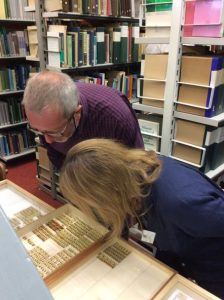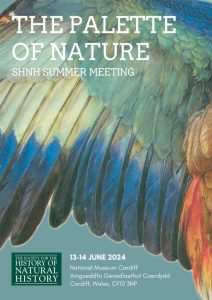‘The Palette of Nature’, National Museum of Wales, Cardiff, Thursday 13 – Friday 14 June 2024
‘The Palette of Nature’: SHNH International Summer Meeting, National Museum of Wales, Cardiff, Thursday 13 – Friday 14 June 2024, with visits on Friday afternoon 14 June
The Society for the History of Natural History is a diverse community of people united by an active interest in the study of natural history through time, believing that a greater awareness of how nature has been considered, documented, valued and exploited by societies and individuals worldwide leads to a deeper understanding and celebration of nature.
is a diverse community of people united by an active interest in the study of natural history through time, believing that a greater awareness of how nature has been considered, documented, valued and exploited by societies and individuals worldwide leads to a deeper understanding and celebration of nature.
The Society is known for its friendliness and its meetings combine intellectual excellence with opportunities for an informal exchange of ideas. It is a focal point for the history of all aspects of natural history. This includes art, literature, biography and bibliography as well as investigative historical studies.
‘The Palette of Nature’
 This two-day international meeting will explore the use and importance of colour within the history of natural history. For centuries, the colours of the natural world have enticed and enthralled observers and led them to develop various means by which to convey this aspect of nature. The aesthetic appeal of certain colours of gemstones or of particular dyes and pigments derived from plants and minerals is apparent in many cultures.
This two-day international meeting will explore the use and importance of colour within the history of natural history. For centuries, the colours of the natural world have enticed and enthralled observers and led them to develop various means by which to convey this aspect of nature. The aesthetic appeal of certain colours of gemstones or of particular dyes and pigments derived from plants and minerals is apparent in many cultures.
This production and use of colour has also been of crucial importance in how the natural world has been described and represented over time. From lavish illustrations in natural history texts to maps and the charts which accompany diagrams, from adjective-laden taxonomic descriptions to stuffed specimens in museums, colour is ever present in how we interact with and think about the natural world.
This conference aims to bring new perspectives to the history of natural history by considering the palette of nature, and the role of colour within its history.
Download the 2024 SHNH Programme & Abstracts for ‘The Palette of Nature’.
Please register to attend through this Eventbrite link.
Registration will close 6pm on Friday 24th May 2024.
For this meeting we have welcomed papers from across the field which speak to any aspects of the history of natural history and speak to the conference theme. Speakers have been convened into sessions of related 20 minute papers with a shared session for questions at the end of each session. Please see the programme below.
Day One
9:15 Arrival and Registration
9:30 Panel 1
Colour charts for naturalists – A brief history
Leslie K. Overstreet, Smithsonian Libraries and Archives
Recording colour in horticulture: The origin and development of the Royal Horticultural Society’s Colour Chart
John David, RHS Garden Wisley
“The tints of a geological map speak to the mind as well as to the eye”: Colour and the representation of empirical reality on the Geological Society’s early maps
Duncan Hawley, History of Geology Group
Q&A
11:00 Break
11:30 Panel 2
Two approaches to ornithological illustration: George Edwards (1694-1773) and Francis Buchanan (1762-1829)
Arthur MacGregor
A Mystery in a Paintbox: Cracking Ferdinand Bauer’s colour code for the Flora Graeca (1786-1794)
Jane Jelley
The transition from uncoloured to coloured engravings in early ichthyology books
Paul Martin, University of Bristol
Q&A
1:00 Lunch
2:00 Panel 3
The palette of nature that made the seventeenth-century florilegia
Jessie Wei-Hsuan Chen, Vrije Universiteit Brussel
Illuminating labour: National pride and female agency in the colouring of the Flora Danica
Christoffer Basse Eriksen, Centre for Science Studies, Aarhus University
Feathered hordes and winged gems: Colour and vitalism in Jardine and Selby’s Illustrations of Ornithology (1827–1843)
Joyce Dixon, University of Edinburgh
Q&A
3:30 Break
3:45 Panel 4
Colours of nature in South Asian art
Cam Sharp Jones, the British Library
Painting descriptions: Observing and authoring nature in Theodor Cantor’s Malayan Sketches, 1840s
Katherine Enright, Trinity College, University of Cambridge
Q&A
4:45 End of Day 1
5:00 All attendees to have left the museum
6:30 Conference Dinner
Côte Cardiff Central
We will require a pre-order and will be in touch with those who book the conference dinner nearer the time to confirm their selections.
Day Two
9:00 Arrival
9:15 Panel 5
“A Matter of Extreme Difficulty:” Robert Ridgway and the classification of colour
Richard Gilreath, Smithsonian Libraries and Archives
Colour charts in 18th-century Europe: Natural, pigmentary, and trichromatic
Giulia Simonini, Technische Universität Berlin
How one illustration of a mountain zebra Equus zebra, living in 1761 at the menagerie of royal palace at Versailles, became emblematic of all black-and-white striped African equines
Graham Rowe, University of Derby
Q&A
10:45 Break
11:00 Panel 6
Hand-coloured natural history illustrations for common readers: The publishing history of The Naturalist’s Library, 1833-1843
Sarah Finn, Milwaukee Public Library, Milwaukee, Wisconsin
Ferdinand Bauer’s (1760 – 1826) field drawings at The Natural History Museum Vienna, his “painting by numbers” method, and the importance of historical colour systems regarding standardisation useful for scientific purposes
Tanja M. Schuster, The Natural History Museum Vienna
Exploring the applications of line drawing in botanical illustration from the eighteenth century to the twenty first century
Heather Pardoe, Amgueddfa Cymru – Museum Wales.
Q&A
12:30 Concluding remarks
12:45 End of conference
Optional
2pm – 4pm Tour of the museum collections
With object highlights from the museum collections linked to the conference papers.
Summer Meeting ECR Bursary
Bursaries are available to current doctoral researchers and post-doctoral researchers within 2 years of completion, who do not have support from their institution, a research grant, or other funding awards, to attend the conference. Applicants should be SHNH members by the time of the conference for which the bursary is awarded. PhD applicants and Masters’ students are not eligible for this award.Bursary applicants must be prepared to assist with the on the day organisation of the meeting. Working alongside the SHNH Meetings Secretary, potential responsibilities include: chairing a panel, social media coverage, manning registration, photography etc. The successful recipient will also be required to submit a reflective report following the meeting for publication on the SHNH website.
The bursary award is up to £300 per ECR applicant for those registered at UK or Ireland institutions, or up to £400 per applicant for those registered at non-UK institutions. Your conference fee will also be waived. The bursaries can be used towards travel and accommodation.
Please apply by 5 April 2024
More information and application form
For more information on the Society please see www.shnh.org.uk.
The Society for the History of Natural History is a diverse community of people united by an active interest in the study of natural history through time, believing that a greater awareness of how nature has been considered, documented, valued and exploited by societies and individuals worldwide leads to a deeper understanding and celebration of nature.
is a diverse community of people united by an active interest in the study of natural history through time, believing that a greater awareness of how nature has been considered, documented, valued and exploited by societies and individuals worldwide leads to a deeper understanding and celebration of nature.
The Society is known for its friendliness and its meetings combine intellectual excellence with opportunities for an informal exchange of ideas. It is a focal point for the history of all aspects of natural history. This includes art, literature, biography and bibliography as well as investigative historical studies.
Registered Charity no. 2103555 in England and Wales
 Archives of Natural History is the journal of the Society for the History of Natural History, publishing papers on the history and bibliography of all branches of natural history. For more information see https://www.euppublishing.com/loi/anh.
Archives of Natural History is the journal of the Society for the History of Natural History, publishing papers on the history and bibliography of all branches of natural history. For more information see https://www.euppublishing.com/loi/anh.